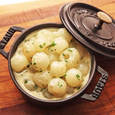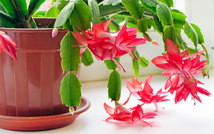|
Ozark Green Thumb BCMG Monthly e-Newsletter |
|
|
|
Soon the weather will be cold and working in the garden will end for the season, here are a few great garden books to read this winter. Some of them are available at our library so check them out.
0 Comments
Seven Baxter County residents recently completed the Master Gardener training offered by the University of Arkansas Division of Agriculture Cooperative Extension Service. The group participated in a 40-hour training program, and each volunteer will donate 40 hours back to the Extension Service in the areas of horticulture and ornamental horticulture.
The group will meet monthly and work on community service projects throughout the coming year. As of November, the Baxter County Master Gardeners have logged 3575 volunteer hours back to the community in 2017. The new Master Gardeners are (from left) Jon Smith, Jennifer Baker, James Wiegand, Debbie Legner, Toni Olden, Jeffrey Pearson and James Loveless. For more information on the Master Gardener program, call 425-2335. The following is a garden checklist:
County Extension Agent Extension office at 425-2335  Common Characteristics: Approximately 1 in. in length, these needles don't even fall when they're dry, providing excellent needle retention. The color is a bright green. The most common Christmas tree in the U.S., the scotch pine has an excellent survival rate, is easy to replant, has great keep ability and will remain fresh throughout the holiday season. Description:
Scotch or Scots pine is an introduced species which has been widely planted for the purpose of producing Christmas trees. It is an extremely hardy species which is adaptable to a wide variety of soils and sites. As a Christmas tree, it is known for its dark green foliage and stiff branches which are well suited for decorating with both light and heavy ornaments. It has excellent needle retention characteristics and holds up well throughout harvest, shipping and display. The needles of Scotch pine are produced in bundles of two. They are variable in length, ranging from slightly over 1-inch for some varieties to nearly 3-inches for others. Color is likewise variable with bright green characteristic of a few varieties to dark green to bluish tones more prominent in others. The undersides of Scotch pine needles are characterized by several prominent rows of white appearing stomatal openings. The bark of upper branches on larger, more mature trees displays a prominent reddish-orange color which is very distinctive and attractive. Large amounts of cones are likewise produced which often persist on the tree from one year to the next. Like most pines two growing seasons are required to produce mature cones. On excellent sites within its native range mature trees may reach a trunk diameter of 30 inches or more and individual trees may exceed 125 feet in height. Range: Scotch pine is native to Europe and Asia. From the British isles and Scandinavian peninsulas through central Europe south to the Mediterranean and east through eastern Siberia, Scotch pine can be found at varying elevations. Scotch pine was introduced to North America by European settlers and has long been cultivated, especially in the eastern United States and Canada. It is adaptable to a wide variety of sites and accordingly, has been widely planted for both Christmas tree and ornamental purposes. Although plantations have been established in the United States for the purpose of producing forest products, the species does not perform as well as in its native habitat. Propagation: Scotch pine is reproduced from seed. More than thirty five different seed sources or varieties are commercially recognized. Seed is obtained by international collectors and marketed through reputable seed dealers. A few seed orchards have been established in the United States from which seed is locally collected. For Christmas tree production purposes seed is usually sown in the spring and the resulting seedlings are allowed to grow for two years in the nursery bed before they are lifted and sold to Christmas tree producers. There has been some research by university personnel to identify and produce genetically improved planting stock, although these efforts have not been totally successful. Uses: In Europe and throughout several countries in Asia, Scotch pine is an important species of high economic value. Forest stands containing Scotch pine are managed to produce pulpwood, poles, and sawlogs from which dimension and finish lumber is produced. Logs from trees of large diameters are processed into veneer and used in manufacturing plywood. The species is also valued as an ornamental and landscape plant and has been widely planted in parks and gardens. As a Christmas tree Scotch pine is probably the most commonly used species in the United States. Because of its ease of planting, generally high planting survival and favorable response to plantation culture it has been widely planted throughout much of the eastern United States and Canada. For several years it was the favorite species of large eastern wholesale growers because of its excellent harvesting and shipping qualities. It is also a preferred species for many choose and cut growers in much of the eastern and central United States. When established in plantations usually 6 to 8 years are required to produce a 7 to 8 foot tree. The tree requires annual shearing, usually beginning the second or third year following planting and continuing on through the year of harvest. Scotch pine is host to a number of insect and disease problems, and continued protection from foliage and stem damaging agents is necessary. The species is not demanding with respect to fertility or moisture and supplemental fertilization or irrigation is not considered necessary. As a Christmas tree Scotch pine is known for its excellent needle retention and good keepability. It resists drying and if permitted to become dry does not drop its needles. When displayed in a water filled container it will remain fresh for the normal 3 to 4 week Christmas season. Like all natural trees it is readily recyclable and has many different uses following the Christmas holidays. Prepared by Dr. Melvin R. Koelling, Michigan State University Copyright © 2017 National Christmas Tree Association  An easy and delicious holiday side dish. Makes 12 servings. Recipe
Directions:
1. In 12 inch skillet, cook frozen onions on medium-high heat 18 to 20 minutes or until liquid releases and then evaporates and onions brown, stirring occasionally. 2. Add butter and reduce heat to medium low. Cook four minutes or until onions are tender, stirring occasionally. 3. Add flour; cook 1 minute, stirring. Add milk in slow steady stream, stirring constantly. Add butter; reduce heat to medium-low. Cook about 10 minutes or until onions are tender, stirring and scraping pan occasionally. 4. Add flour; cook 1 minute, stirring. Add milk in slow, steady stream, stirring constantly. Add thyme and bay leaf; heat to boiling on medium, stirring occasionally. 5. Simmer 5 minutes, stirring, until mixture is creamy and thickened. 6. Season with nutmeg, 1/2 tsp. salt and 1/4 teaspoon freshly ground black pepper. Remove bay leaf and thyme. Serve hot.  How to Grow and Care for Christmas Cactus: A Christmas Cactus is a tropical plant that does not naturally exist in nature. It was bred from two unique parent plants that both grow in the South American rain forests, specifically in Brazil. The plant is recognizable by its segmented stem and the brightly colored blooms that appear at the ends of them. Blooms are typically red, pink, purple, yellow, or white, and the blooms can occur at different times throughout the year. Most notably, they can appear near Christmas, which is where the name is derived. Since this plant is one of the rare plants that bloom at this time of year, it takes a bit of care to ensure that blooms do occur. This guide will give you all of the basics that you need to tend to a Christmas Cactus and help you make your home more colorful during the holiday season. How to Care for Christmas Cactus: Christmas Cactuses are not actually cactuses at all; in fact, they require care that is very similar to a succulent. They do not require a lot of special care, but they do need to be properly maintained in order for blooms to appear. Let’s take a look at some of the tips that will help your Christmas Cactus flourish. 1. Watering Christmas Cactus: Like most succulent plants, it requires moist soil to grow; however, these plants do not like to be sitting in a pool of water. The best way to know when your Christmas Cactus needs to be watered is to check the soil. Once the top of the soil feels dry to the touch, water it again. Too much water can cause brown spots or root rot, while too little can cause issues with the blooms. 2. Soil and Fertilizer for Christmas Cactus: Christmas Cactuses require soil that is well-draining, which means that a mixture of normal potting soil and fine bark works perfectly. You can also use sand or small stones in the base of the pot to help with drainage. Insofar as fertilizer, this plant should be fed every two weeks with a diluted liquid fertilizer. Make sure to stop feeding it about a month before the winter bloom, which typically means the end of the month of October. 3. Christmas Cactus Lighting Tips: This plant likes a lot of sunlight, but it prefers indirect light. Direct sunlight can easily burn the leaves of the plant, so windows that are facing east or north are best. A Christmas Cactus is able to adapt to low light conditions, but it thrives in bright, indirect light. 4. Re-potting and Pruning Needs: Christmas Cactus plants prefer to be confined to a snug pot where the roots are nearly too large for the pot. This lack of space for the root system actually produces the best blooms. This means that the plant will not need to be re-potted more than once every two to three years. When the transfer does need to occur, never re-pot a Christmas Cactus while it is in bloom. I have found that re-potting the plant in spring or early summer works the best, and it allows the plant time to settle before blooming for the holiday season. Pruning the plant should occur about a month after the blooming period is complete. This will encourage the plant to branch out and start growing again after a short period of rest. To prune a Christmas Cactus, simply twist the stem between the segments on the stem and remove the section. If your plant is becoming unruly, then you can remove up to 1/3 of the Christmas Cactus each year without causing damage to the plant. 5. Propagation: Propagating a Christmas Cactus is easy, all you need to do is take the trimmed sections of the plant that you cut off during the pruning process and place them in a new pot of soil to grow. For the best results, propagation should be done in the spring of the year, and at last one segment of the plant should be buried underneath the soil. 6. How to get a Christmas Cactus to Bloom: To encourage blooms to form you must create certain conditions for the plant. The temperature must be between 50 and 55 degrees Fahrenheit each night from the end of October, which is about six to eight weeks before Christmas. The room must be completely dark for 12 to 14 hours each night as well. Christmas Cactuses can be difficult plants to care for, but with a little bit of effort, you will have a delightful blooming plant right around the holiday season that your family and friends can envy. Excerpt from: Garden Lovers Club
 Not only is there a surprise in the center of each cookie, the recipe for Surprises is surprisingly simple too! INGREDIENTS:
INSTRUCTIONS: 1. Preheat oven to 35oF. Coat baking sheets with cooking spray.
2. In a large bowl, cream together butter, sugar, and vanilla. 3. Stir in flour and salt. 4. Form dough into 1 inch balls then press a cherry into the center of each. Reshape each into a ball, completely covering the cherry. 5. Roll the balls in shredded coconut and place two inches apart on prepared baking sheets. 6. Bake 20 minutes then cool on wire racks. Makes about two dozen cookies. |
Archives
April 2022
|
|

